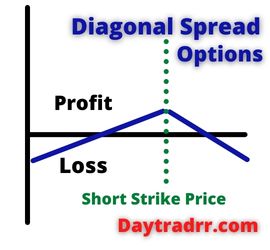What are Diagonal Spread Options?
 Diagonal spread options refers to buying and selling equal amounts of call or put option contracts with different strike prices and expiration dates. In options trading, the strategy is a modified calendar spread involving different strike prices. It is put into play by simultaneously entering into a long and short position in two options of the same type. This can either be two call options or two put options. However, with different strike prices and different expiration dates.
Diagonal spread options refers to buying and selling equal amounts of call or put option contracts with different strike prices and expiration dates. In options trading, the strategy is a modified calendar spread involving different strike prices. It is put into play by simultaneously entering into a long and short position in two options of the same type. This can either be two call options or two put options. However, with different strike prices and different expiration dates.
This tactic can be bullish or bearish, depending on the structure and the options that are used. The strategy combines horizontal, or calendar spread as well as a vertical spread. The term diagonal spread comes from the options chain layout where the two options contract with different strike prices and expiration dates would be diagonally oriented.
Diagonal Spread Options Strategy – A Closer Look
This strategy is known as a diagonal spread. It uses a horizontal spread which is also known as a time spread or calendar spread. However, there is a difference in expiration dates. The horizontal spread is combined with a vertical spread or price spread. The key element is the difference in strike prices. The placement of each option on an options grid is referred to as a horizontal, vertical, and diagonal spread.
The strike prices and expiration dates of options are listed in a matrix. Vertical spread strategies with the same expiration dates are all displayed in the same vertical column. On the other hand, options in a horizontal spread strategy have the same strike price but various expiration dates. As a result, the selections are placed horizontally on a calendar. Options in diagonal spreads have different strike prices and expiration dates. As a result, they are arranged diagonally on the quote grid.
Call Diagonal Spread Options Strategy
A call diagonal spread is a multi-leg, neutral to a bearish strategy with risk-defined profit potential. Call diagonal spreads profit from time decay and a drop in the underlying stock’s price. Call diagonal spreads are made up of two call options. A short call option is sold, and a long call option is purchased. The long call option has a higher strike price and a later expiration date than the short call option. In other words, a call diagonal spread is formed by combining a bear call credit spread and a call calendar spread. Call diagonal spreads can be opened with either a debit or a credit. If the underlying stock price is lower than the short call at the front-month expiration, the approach is successful. The back-month, long call option protects the strategy and defines its risk if the stock price rises.
This strategy is used when an investor believes the stock price will be neutral or negative in the short term, Similar to a bear call spread, the near-term short call option gains from the underlying stock’s price decrease. Because of its longer time horizon, the long call option will keep its value better than a normal bear call spread. A rise in volatility will also help add value to the long contract’s premium. Also, it may help offset a value decrease due to a falling stock price.
Outlook
The goal is for the underlying stock price to close below the strike price of the short call option at the first expiration date. The short call option would then be worthless at expiration, but the long call option would retain extrinsic value. At this point, an investor can choose to close the long call option position or keep it open if they believe the stock will reverse and rise. Another short call option could be sold to generate more credit. The expiration date of the short contract must be the same as the expiration date of the long call. This would result in a standard spread position. (Source: optionalpha.com)
Call Diagonal Spread Example
Consider a company that is trading at or below $70. An investor feels it will remain below $70 into the foreseeable future. A call diagonal spread might be entered by selling a $70 call option. At the same time, purchasing a $75 call option with a later expiration date. If the trade earns $1.00 in credit, the maximum loss at the front-month expiration is capped at $400.
However, the maximum potential profit is flexible. It is determined by whether or not the long call is closed at the front-month expiration. However, a premium of $100 is collected at the time the transaction is entered into. Therefore, if the short call expires worthless, the $100 premium represents a guaranteed profit. The long call might be sold at the front-month expiration to generate more profit. Or, the investor could hold the long position if they believe the underlying stock price will rise.
Closing a Call Diagonal Spread
The choice to exit a call diagonal spread is at the discretion of the trader. It is determined by the price of the underlying asset at the expiration of the short call contract. If the stock price falls below the strike price of the short call, the option will expire worthless. The long call option will be out-of-the-money and have no remaining time value. The extrinsic time value will be determined by the amount of time till expiration and the strike price in relation to the stock price.
Theta, or time value, works against the long option. As a result, the contract’s value decreases rapidly as it approaches expiration. When the investor chooses to exit the long call position, a sell-to-close (STC) order will be entered. If the underlying stock price is higher than the strike price of the short call at the initial expiration date, both options may be closed to exit the position. This will result in the trade’s maximum loss.
Types of Diagonal Spread Options
There are multiple combinations for diagonal spreads in options trading. This is because each option spread has two different elements. Namely, the strike price and the expiration date. These trading strategies can be bullish or bearish, long or short, and use put or call options. The only prerequisite for most diagonal spreads is that the holder buys the option with the longest expiration date and sells the option with the shorter expiration date. This holds true for both call diagonals and put diagonals. Of course, the opposite is also true. Short spreads entail the holder purchasing the shorter expiration and selling the longer expiration. The combination of strike prices determines whether a long or short strategy is bullish or bearish.
Long Put Diagonal Spread
A Long Put Diagonal Spread is structured by purchasing a put far in the future. At the same time, selling a near-term put on a higher out-of-the-money (OTM) strike to minimize cost basis. The trade has only two legs. However, it has the directionality of a long vertical spread and the positive vega of a calendar spread. As a result, a bearish position is formed, which can benefit from an increase in implied volatility. A Long Put Diagonal Spread is typically used to simulate a covered put position. (Source: tastytrade.com)
Long Call Diagonal Spread
To lower cost, a long call diagonal spread can be created by acquiring a call further out in time. Simultaneously, selling a near term call on a further out-of-the-money strike. This trade has only two legs. However, it features the directionality of a long vertical spread and the positive vega of a calendar spread. As a result, a bullish position is formed, which can benefit from an increase in implied volatility. Typically, a Long Call Diagonal Spread is employed to simulate a covered call position.
In a bullish long call diagonal spread, for example, buy the option with the longer expiration date and lower strike price and sell the option with the shorter expiration date and higher strike price. As an example, consider purchasing one December $20 call option and simultaneously selling one April $25 call option. (Source: ibid)
Final Words
A diagonal spread options are typically constructed on a 1:1 basis. The strategy uses a lengthy vertical and long calendar spread resulting in a debit to the account. The combinations of strikes and expirations vary with diagonal spreads. However, a long diagonal spread is normally set up as a debit while a short diagonal spread is set up as a credit. In addition, the most straightforward approach is to close the trade when the shorter option expires. Many traders, however roll the strategy forward. Commonly replacing the expired option with a new option. The new option has the same strike price but an expiration date closer to the lengthier option.
Up Next: The Settlor of a Trust – What Does That Mean?
 The settlor of a trust is the person who creates a trust to be managed by a trustee for the benefit of another party called the beneficiary. The settlor of a trust plans, creates, and funds the trust. Without the settlor, the trust would simply not exist.
The settlor of a trust is the person who creates a trust to be managed by a trustee for the benefit of another party called the beneficiary. The settlor of a trust plans, creates, and funds the trust. Without the settlor, the trust would simply not exist.
A settlor of a trust is the person that establishes the trust. The settlor can go by several other names including donor, grantor, and trustor. Regardless of what this person is called, his or her role is to legally establish the trust and transfer control of an asset to a trustee. The trustee then manages the assets in the trust for one or more beneficiaries.
In certain types of trusts, the settlor may also be the beneficiary, the trustee, or both. The key players in a trust are as follows:




